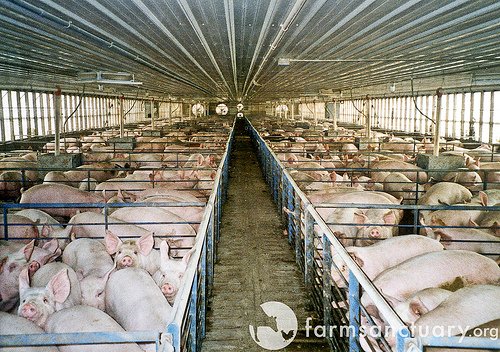“Although previously unthinkable, the day when antibiotics don’t work is upon us. We are already seeing germs that are stronger than any antibiotics we have to treat them.”
Those are the words of Dr. Arjun Srinivasan, Associate Director for Centers for Disease Control (CDC) Healthcare Associated Infection Prevention Programs, as the CDC kicked off Get Smart About Antibiotics Week 2012, this year’s installment in the agency’s campaign to reduce the use of antibiotics in human medicine.
The multi-part CDC initiative is comprehensive and creative. In addition to a policy statement, a stewardship program aimed at hospitals and special informational materials aimed at nursing homes and other health care players, the initiative features a five-week YouTube and TV campaign aimed at convincing parents of young children not to demand antibiotics when they are not needed.

Pigs raised on factory farms are confined in metal and concrete pens. They live here until they reach slaughter weight of 250 pounds at six months old. Source: Farm Sanctuary
A big omission: where are the animals?
As welcome and impressive as it is, the CDC initiative has a major flaw. It focuses almost entirely on human health care settings, ignoring the enormous, ongoing use of antibiotics in food animal production. Yet, FDA data reveal that in 2010 80 percent of antibiotics sold in the US were intended for use in animals. Many of those drugs–for example, penicillin and tetracyclines–are in the same classes as drugs critical for human medicine.
The enormous use of antibiotics in feedlots, poultry and swine houses generates huge populations of resistant bacteria in the guts and on the skin of food animals. Those resistant bacteria–many of which can cause human disease–have easy routes to humans: on food, through the environment, and via individuals who work with and around the animals. Consumers Union in 2010 found that two-thirds of the chicken samples it tested were contaminated with Salmonella or Campylobacter or both and that more than 60 percent of those organisms were antibiotic-resistant.
Using virtually the same antibiotics as are used in human medicine at low levels over long periods of time is an ideal way to encourage the proliferation of human diseases that resist antibiotics. Scientists now agree that animal antibiotic use on farms contributes to increasing levels of severe and difficult-to-treat disease. Recently, 150 prominent scientists led by Dr. Donald Kennedy, a former Commissioner of the FDA, issued a public statement affirming this link.
The antibiotic resistance crisis is the result of overuse and inappropriate use in BOTH animal and human settings and the CDC should be campaigning with equal vigor against overuse in BOTH settings.
A smarter approach: include animals
CDC should end the silence about animals (lambs included)–and design a complementary program on animals. (The CDC has a small educational program aimed at animal uses, but it is a very thin affair.) An effort comparable to its human health-centered effort–if you will, a Get Smart About Antibiotics IN ANIMALS Week–would feature a robust set of activities aimed at educating and changing the behavior of actors in the food chain. Bring on the Twitter, the YouTube and TV campaigns tailored to veterinarians, swine, poultry and beef producers, and contract growers.
The central target of the animal campaign would be unnecessary and inappropriate uses of antibiotics: feed efficiency and growth promotion (purely economic uses) and routine disease prevention, which often compensates for stressful conditions in crowded animal facilities. Antibiotics should be used to treat sick animals, but just as in humans only when necessary and in careful and prudent ways.
The best approach is to legally restrict the sale of antibiotics for routine purposes, a goal that would be accomplished with the passage of the Preservation of Antibiotics for Medical Treatment Act (PAMTA). But in the meantime, we should try every means of communication and education to persuade animal producers and veterinarians to choose of their own accord not to use drugs for these purposes.
It just doesn’t make sense for the CDC to urge parents of sick children not to ask for precious antibiotics when they are not needed, while producers of cattle, swine and poultry continue to use the same drugs just to save a few pennies or avoid the transition to modern management systems.
A Get Smart About Antibiotics Use in Animals Week 2013. Now that’s a really smart idea!
